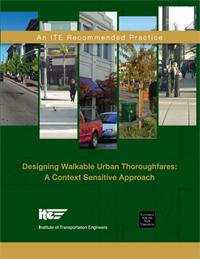Designing Walkable Urban Thoroughfares: A Context Sensitive Approach
The Institute of Transportation Engineers' (ITE) Designing Walkable Urban Thoroughfares: A Context Sensitive Approach Exit(2010) provides guidance for practitioners to design major urban streets to support walkable and bikeable communities, compact development, and mixed land uses.
The report includes chapters on incorporating context sensitive solutions into transportation planning and project development, specific design criteria, and case studies where these approaches have been successfully applied.
The report was funded by EPA and the Federal Highway Administration (FHWA) in partnership with the Congress for the New Urbanism. ITE officially adopted this report as a recommended practice in 2010.
FHWA defines context sensitive solutions as “a collaborative, interdisciplinary approach that involves all stakeholders in providing a transportation facility that fits its setting. It is an approach that leads to preserving and enhancing scenic, aesthetic, historic, community, and environmental resources, while improving or maintaining safety, mobility, and infrastructure conditions.” For more information and resources on context sensitive solutions, visit FHWA’s Context Sensitive Solutions page.
Find more resources on smart growth and transportation.

